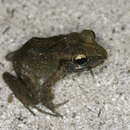Description
provided by AmphibiaWeb articles
Is a moderate-sized (males 30-35 mm SVL, females to 60 + mm), narrow-toed, terrestrial member of the genus. It is exceedingly variable in color and pattern, with ground color ranging from pale yellow-tan to very dark brown, sometimes patternless but with a bewildering variety of pattern elements in most individuals, including spots, blotches, and/or striping in several different ways (dorsolateral, broad or narrow middorsal stripe, vertebral hairline that may or may not extend onto the dorsal legs). Posterior/ventral thigh and groin color, often a useful character to distinguish species in more diverse faunas, are similarly variable: no “flash colors” at all, translucent lavender, pale orange to brighter salmon, or even dull chestnut on the posterior thighs.
Crombie, R. I., and Pregill, G. K. (1999). ''A checklist of the herpetofauna of Palau (Republic of Belau), Oceania.'' Herpetological Monographs, 13, 29-80.
Distribution and Habitat
provided by AmphibiaWeb articles
Endemic to Palau. The distribution extends from the northernmost edge of the archipelago (Kayangel Atoll, outside the main reef) to the southernmost island (Angaur, also just outside the reef) but frogs are NOT found on the Southwest Islands, politically part of Palau but biogeographically distinct and geographically remote from “core Palau.” Frogs are found on all the larger islands and many incredibly small ones, but are inexplicably absent from some smaller islands that seem ecologically suitable with no apparent pattern to the presence/absence. There are no obvious habitat preferences, as frogs are abundant in back yards in Koror town, primary forest, and almost everything in between. Specimens have been heard and collected at the edges of brackish mangrove or Nipa swamps and even the harsh Pandanus savannahs on Babeldaob, stiflingly hot and dry by day, have deafening choruses of Platymantis after dark, the tangled roots of ferns and grasses obviously retaining enough moisture to support plenty of frogs.
Life History, Abundance, Activity, and Special Behaviors
provided by AmphibiaWeb articles
Despite the species’ abundance, reproductive behavior is very poorly known. Like other Platymantis, direct development (terrestrial nests of large eggs that hatch into froglets, lacking a free tadpole stage) is confirmed but egg clutches have been reported only twice and none of the important details are included in the notes. With some females being almost twice the size of males, traditional methods of egg fertilization via amplexus would be non-functional as the cloaca of the male would be nowhere near that of the female so the eggs could not be fertilized as they were deposited. No amplectant pairs have been found among the hundreds of specimens seen and collected, further suggesting that egg deposition and fertilization may include some innovative twists. An attendant frog (or frogs) and even parental care is common in direct-developing species but this information is unknown for P. pelewensis. The Palau frog has a broad, non-discriminating diet including a wide variety of invertebrate and even vertebrate prey items. In addition to the usual arthropods, snails are often found in guts and the large cave frogs occasionally eat smaller ones. The autotomized tails of a small skink (Sphenomorphus scutatus) and gecko (Lepidodactylus moestus) were also found in (different) cave frog guts, suggesting that opportunistic feeding on small vertebrates is possible.
Life History, Abundance, Activity, and Special Behaviors
provided by AmphibiaWeb articles
No known threats. Is common and widespread with no indication of population declines in the past 12+ years (1992 – present) of survey work on Palau vertebrates.
Relation to Humans
provided by AmphibiaWeb articles
If nocturnal choruses are any indication, the species has flourished with human modification and “development” of Palau, and it could even be considered an effective human commensal. In forested areas frogs are common but well dispersed, as opposed to the very dense aggregations in disturbed areas, backyard banana patches and mango trees provide enough shade and moisture to support large numbers of frogs. Crombie and Pregill (1999) noted that females and juveniles often congregate in caves, including manmade or modified cave-like structures (Japanese tunnels, bunkers, gun emplacement etc. left over from WW II).
Cornufer pelewensis
provided by wikipedia EN
Cornufer pelewensis, commonly known as Palau frog or Palau wrinkled ground frog, is a species of frog in the family Ceratobatrachidae. It is endemic to Palau.
Its natural habitats are subtropical or tropical dry forests, subtropical or tropical moist lowland forests, subtropical or tropical mangrove forests, dry savanna, moist savanna, subtropical or tropical dry shrubland, subtropical or tropical moist shrubland, rocky areas, caves, plantations, rural gardens, urban areas, heavily degraded former forest, and man-made karsts.
References
Audio recording of the Palau Frog calling in Koror Palau in May 2013

- license
- cc-by-sa-3.0
- copyright
- Wikipedia authors and editors
Cornufer pelewensis: Brief Summary
provided by wikipedia EN
Cornufer pelewensis, commonly known as Palau frog or Palau wrinkled ground frog, is a species of frog in the family Ceratobatrachidae. It is endemic to Palau.
Its natural habitats are subtropical or tropical dry forests, subtropical or tropical moist lowland forests, subtropical or tropical mangrove forests, dry savanna, moist savanna, subtropical or tropical dry shrubland, subtropical or tropical moist shrubland, rocky areas, caves, plantations, rural gardens, urban areas, heavily degraded former forest, and man-made karsts.
- license
- cc-by-sa-3.0
- copyright
- Wikipedia authors and editors


